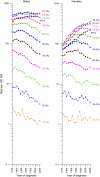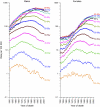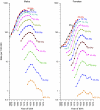Annual report to the nation on the status of cancer, 1975-2005, featuring trends in lung cancer, tobacco use, and tobacco control - PubMed (original) (raw)
. 2008 Dec 3;100(23):1672-94.
doi: 10.1093/jnci/djn389. Epub 2008 Nov 25.
Michael J Thun, Lynn A G Ries, Holly L Howe, Hannah K Weir, Melissa M Center, Elizabeth Ward, Xiao-Cheng Wu, Christie Eheman, Robert Anderson, Umed A Ajani, Betsy Kohler, Brenda K Edwards
Affiliations
- PMID: 19033571
- PMCID: PMC2639291
- DOI: 10.1093/jnci/djn389
Annual report to the nation on the status of cancer, 1975-2005, featuring trends in lung cancer, tobacco use, and tobacco control
Ahmedin Jemal et al. J Natl Cancer Inst. 2008.
Abstract
Background: The American Cancer Society, the Centers for Disease Control and Prevention (CDC), the National Cancer Institute (NCI), and the North American Association of Central Cancer Registries (NAACCR) collaborate annually to provide updated information on cancer occurrence and trends in the United States. This year's report includes trends in lung cancer incidence and death rates, tobacco use, and tobacco control by state of residence.
Methods: Information on invasive cancers was obtained from the NCI, CDC, and NAACCR and information on mortality from the CDC's National Center for Health Statistics. Annual percentage changes in the age-standardized incidence and death rates (2000 US population standard) for all cancers combined and for the top 15 cancers were estimated by joinpoint analysis of long-term (1975-2005) trends and by least squares linear regression of short-term (1996-2005) trends. All statistical tests were two-sided.
Results: Both incidence and death rates from all cancers combined decreased statistically significantly (P < .05) in men and women overall and in most racial and ethnic populations. These decreases were driven largely by declines in both incidence and death rates for the three most common cancers in men (lung, colorectum, and prostate) and for two of the three leading cancers in women (breast and colorectum), combined with a leveling off of lung cancer death rates in women. Although the national trend in female lung cancer death rates has stabilized since 2003, after increasing for several decades, there is prominent state and regional variation. Lung cancer incidence and/or death rates among women increased in 18 states, 16 of them in the South or Midwest, where, on average, the prevalence of smoking was higher and the annual percentage decrease in current smoking among adult women was lower than in the West and Northeast. California was the only state with decreasing lung cancer incidence and death rates in women.
Conclusions: Although the decrease in overall cancer incidence and death rates is encouraging, large state and regional differences in lung cancer trends among women underscore the need to maintain and strengthen many state tobacco control programs.
Figures
Figure 1
Trends in age-standardized lung cancer incidence and death rates by sex, United States, 1975–2005. Solid lines represent fitted values based on joinpoint analyses. Squares represent observed rates. SEER-9 incidence data for 1975–2005 are from the Surveillance, Epidemiology, and Ends Results (SEER)-9 areas and or cover 10% of the US population. US incidence data from 1996 to 2005 are from 29 SEER and or National Program of Cancer Registries areas reported by the North American Association of Central Cancer Registries as meeting high-quality data standards and cover about 65% of the US population. SEER-9 incidence data are adjusted for delays in reporting, but US incidence data are not. US and SEER-9 mortality data for 1975–2005 are from the National Center for Health Statistics, 2005 Mortality Special Research File.
Figure 2
Trends in age-specific lung cancer incidence rates by year of diagnosis and sex, United States, 1975–2005. Data are from Surveillance, Epidemiology, and Ends Results (SEER)-9 areas, and data points are based on 2-y average rates with the exception of the last point, which averages 3-y rates (1975–1976, 1977–1978, …, 2001–2002, 2003–2005). The SEER-9 areas cover about 10% of the US population.
Figure 3
Trends in age-specific lung cancer death rates by year of death and sex, United States, 1950–2005. Rates include cancers of the lung, bronchus, pleura, and trachea. Data are from the National Center for Health Statistics, 2005 Mortality Special Research File.
Figure 4
Trends in age-specific lung cancer death rates by year of birth and sex, United States, 1865–1970. Rates include cancers of the lung, bronchus, pleura, and trachea. The points vertically above each cohort year portray the cohort's age-specific mortality experience. Data are from the National Center for Health Statistics, 2005 Mortality Special Research File.
Figure 5
Trends in age-standardized lung cancer death rate for the US and selected states by sex, 1975–2005. Solid lines represent fitted values based on joinpoint analyses. Squares represent observed rates. Data are from the National Center for Health Statistics, 2005 Mortality Special Research File.
Figure 6
Initiation of smoking among 12- to 17-year-old adolescents in the United States by sex, 1940–2000. All calculations to determine the year in which respondents began smoking were based on the survey administration date in conjunction with responses given in the survey regarding initiation age of “regular” use and current age. Data are from the Tobacco Use Supplements to the Current Population Survey (25,26). Means and 95% confidence intervals (error bars) are shown.
Similar articles
- Annual report to the nation on the status of cancer, 1975-2000, featuring the uses of surveillance data for cancer prevention and control.
Weir HK, Thun MJ, Hankey BF, Ries LA, Howe HL, Wingo PA, Jemal A, Ward E, Anderson RN, Edwards BK. Weir HK, et al. J Natl Cancer Inst. 2003 Sep 3;95(17):1276-99. doi: 10.1093/jnci/djg040. J Natl Cancer Inst. 2003. PMID: 12953083 Review. - Annual report to the nation on the status of cancer, 1975-2006, featuring colorectal cancer trends and impact of interventions (risk factors, screening, and treatment) to reduce future rates.
Edwards BK, Ward E, Kohler BA, Eheman C, Zauber AG, Anderson RN, Jemal A, Schymura MJ, Lansdorp-Vogelaar I, Seeff LC, van Ballegooijen M, Goede SL, Ries LA. Edwards BK, et al. Cancer. 2010 Feb 1;116(3):544-73. doi: 10.1002/cncr.24760. Cancer. 2010. PMID: 19998273 Free PMC article. - Annual report to the nation on the status of cancer, 1975-2002, featuring population-based trends in cancer treatment.
Edwards BK, Brown ML, Wingo PA, Howe HL, Ward E, Ries LA, Schrag D, Jamison PM, Jemal A, Wu XC, Friedman C, Harlan L, Warren J, Anderson RN, Pickle LW. Edwards BK, et al. J Natl Cancer Inst. 2005 Oct 5;97(19):1407-27. doi: 10.1093/jnci/dji289. J Natl Cancer Inst. 2005. PMID: 16204691 - Annual report to the nation on the status of cancer, 1975-2007, featuring tumors of the brain and other nervous system.
Kohler BA, Ward E, McCarthy BJ, Schymura MJ, Ries LA, Eheman C, Jemal A, Anderson RN, Ajani UA, Edwards BK. Kohler BA, et al. J Natl Cancer Inst. 2011 May 4;103(9):714-36. doi: 10.1093/jnci/djr077. Epub 2011 Mar 31. J Natl Cancer Inst. 2011. PMID: 21454908 Free PMC article.
Cited by
- Hospicells promote upregulation of the ATP-binding cassette genes by insulin-like growth factor-I via the JAK2/STAT3 signaling pathway in an ovarian cancer cell line.
Benabbou N, Mirshahi P, Cadillon M, Soria J, Therwath A, Mirshahi M. Benabbou N, et al. Int J Oncol. 2013 Sep;43(3):685-94. doi: 10.3892/ijo.2013.2017. Epub 2013 Jul 15. Int J Oncol. 2013. PMID: 23857432 Free PMC article. - Targeting the intrinsic inflammatory pathway: honokiol exerts proapoptotic effects through STAT3 inhibition in transformed Barrett's cells.
Yu C, Zhang Q, Zhang HY, Zhang X, Huo X, Cheng E, Wang DH, Arbiser JL, Spechler SJ, Souza RF. Yu C, et al. Am J Physiol Gastrointest Liver Physiol. 2012 Sep 1;303(5):G561-9. doi: 10.1152/ajpgi.00033.2012. Epub 2012 Jun 28. Am J Physiol Gastrointest Liver Physiol. 2012. PMID: 22744336 Free PMC article. - Honokiol induces cytotoxic and cytostatic effects in malignant melanoma cancer cells.
Kaushik G, Ramalingam S, Subramaniam D, Rangarajan P, Protti P, Rammamoorthy P, Anant S, Mammen JM. Kaushik G, et al. Am J Surg. 2012 Dec;204(6):868-73. doi: 10.1016/j.amjsurg.2012.09.001. Am J Surg. 2012. PMID: 23231930 Free PMC article. - Economic analyses of breast cancer control in low- and middle-income countries: a systematic review.
Zelle SG, Baltussen RM. Zelle SG, et al. Syst Rev. 2013 Apr 8;2:20. doi: 10.1186/2046-4053-2-20. Syst Rev. 2013. PMID: 23566447 Free PMC article. Review. - Regional variation in identified cancer care needs of early-career oncologists in China, India, and Pakistan.
Lyerly HK, Fawzy MR, Aziz Z, Nair R, Pramesh CS, Parmar V, Parikh PM, Jamal R, Irumnaz A, Ren J, Stockler MR, Abernethy AP. Lyerly HK, et al. Oncologist. 2015 May;20(5):532-8. doi: 10.1634/theoncologist.2014-0213. Epub 2015 Apr 17. Oncologist. 2015. PMID: 25888267 Free PMC article.
References
- Wingo PA, Ries LA, Rosenberg HM, Miller DS, Edwards BK. Cancer incidence and mortality, 1973–1995: a report card for the U.S. Cancer. 1998;82(6):1197–1207. - PubMed
- Wingo PA, Ries LA, Giovino GA, et al. Annual report to the nation on the status of cancer, 1973–1996, with a special section on lung cancer and tobacco smoking. J Natl Cancer Inst. 1999;91(8):675–690. - PubMed
- Ries LA, Wingo PA, Miller DS, et al. The annual report to the nation on the status of cancer, 1973–1997, with a special section on colorectal cancer. Cancer. 2000;88(10):2398–2424. - PubMed
- Howe HL, Wingo PA, Thun MJ, et al. Annual report to the nation on the status of cancer (1973 through 1998), featuring cancers with recent increasing trends. J Natl Cancer Inst. 2001;93(11):824–842. - PubMed
- Edwards BK, Howe HL, Ries LA, et al. Annual report to the nation on the status of cancer, 1973–1999, featuring implications of age and aging on U.S. cancer burden. Cancer. 2002;94(10):2766–2792. - PubMed
Publication types
MeSH terms
LinkOut - more resources
Full Text Sources
Other Literature Sources
Medical
Molecular Biology Databases





